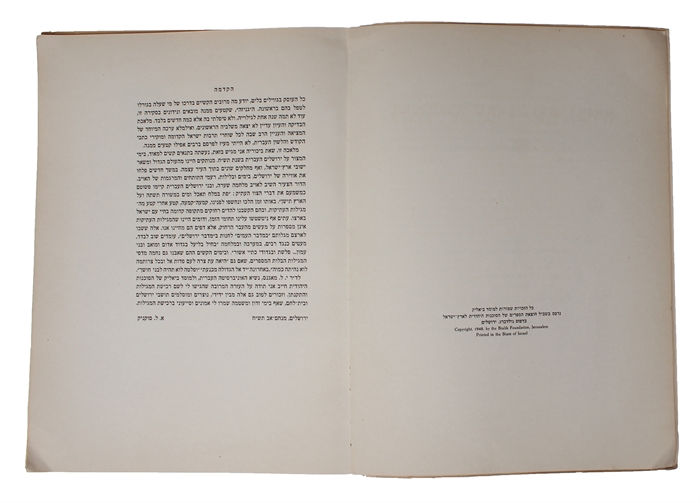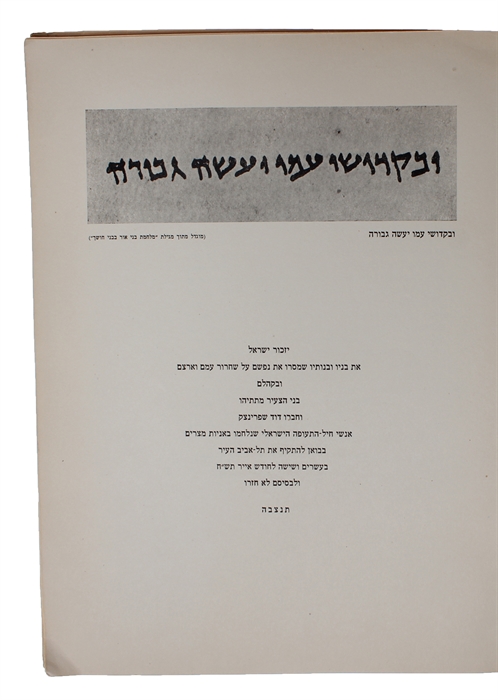FIRST PUBLISHED STUDY ON THE DEAD SEA SCROLLS.
E. L. SUKENIK.
Megilloth Genuzoth. (i.e. "Scrolls hidden away", preliminary survey on 'Dead Sea Scrolls').
Jerusalem, Bialik Foundation. 1948.
Large 4to (325 x 235 mm). In the original printed wrappers. Extremities with light marginal miscolouring and a bit creased. Verso of wrappers with offsetting, otherwise a fine copy. (6), 43 pp. + 13 plates.
The very first publication of any part of the Dead Sea Scroll. With the present publication, Sukenik also became the first to linking the scrolls and their content to a community of Essenes, which became the standard interpretation of the origin of the scrolls, a theory that is still the general consensus among scholars. Sukenik's role was significant in acquiring and studying some of the Dead Sea Scrolls after their initial discovery. In 1948, he managed to acquire three of the scrolls from an antiquities dealer in Bethlehem, including the famous "Isaiah Scroll." (the two others being The War Scroll and the Thanksgiving Scroll (Hodayot)). Sukenik almost immediately recognized the historical and scholarly importance of the scrolls and worked to secure them for research purposes. His efforts helped bring attention to the scrolls and contributed to their preservation and study. Sukenik recollected in his diary:"My hands shook as I started to unwrap one of them. I read a few sentences. It was written in beautiful biblical Hebrew. The language was like that of the Psalms, but the text was unknown to me. I looked and looked, and I suddenly had the feeling that I was privileged by destiny to gaze upon a Hebrew Scroll which had not been read for more than 2,000 years." Eleazar Sukenik, along with Roland de Vaux, emerged as among the earliest scholars engaged in the study of the initial scrolls unearthed in 1947. Sukenik swiftly established a connection between these scrolls and the settlement at Qumran, positioned on the northwest bank of the Dead Sea, specifically attributing them to a Jewish sect identified as the Essenes. In 1951, de Vaux conducted excavations at the Qumran site, unearthing pottery that bore an identical resemblance to the pottery discovered in nearby Cave 1 (the scrolls had been extracted from a sequence of 11 caves, each numbered by archaeologists based on their order of discovery). This further solidified Sukenik's correlation between the caves, their contents, and the adjacent archaeological remains of the Qumran settlement. The Qumran-Essene hypothesis put forth by these prominent figures in archaeology subsequently became the prevailing theory, endorsed in scholarly publications and reference works. While a group of experts commenced the task of translating the scrolls in the 1950s, the wider academic community had to wait nearly four decades before gaining access to them.
The Dead Sea Scrolls are regarded as a pivotal cornerstone in the realm of archaeology, possessing immense historical, religious, and linguistic importance. These scrolls comprise the most ancient extant manuscripts of complete books that would eventually find their place in the biblical canons. Additionally, they house deuterocanonical and extra-biblical manuscripts, providing valuable testimony to the multiplicity of religious ideologies during the period of late Second Temple Judaism.
Order-nr.: 60465




